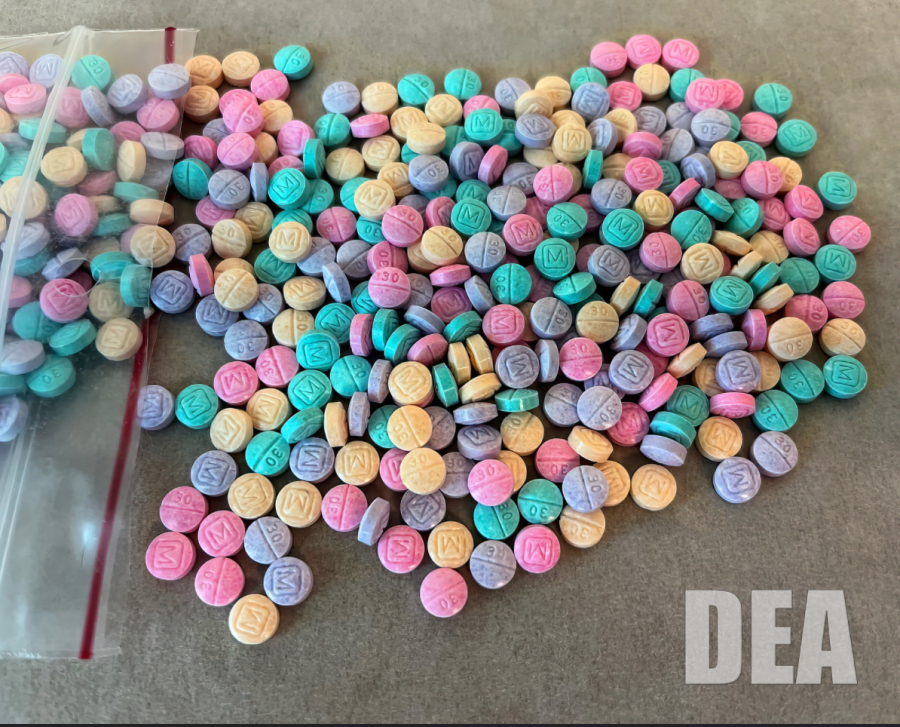Drug dealers are selling colorful pills laced with fentanyl, dubbed “rainbow fentanyl,” as a marketing ploy to drive addiction among kids and young adults.
First discovered by the Drug Enforcement Administration (DEA) in August 2022, drug cartels designed rainbow fentanyl to appeal to younger consumers, contributing to the recent rise in fentanyl-related deaths.
“Drug dealers don’t care if you die; they want to make money. They look for the quickest, most profitable ways to make and deliver their products,” said Shelley Bustamante, who has been the crisis therapist at Carlmont for the last 20 years. “It’s all about the money.”
Rainbow fentanyl comes in various colors, such as pink, green, yellow, purple, and blue. It is sold as pills, powders, or chunks that resemble sidewalk chalk.
“The rainbow pills are being produced in Mexico by utilizing a food coloring and are still stamped with an M30 to symbolize an oxycodone,” said DEA special agent Casey Rettig.
Many illicit drugs sold by dealers contain enough fentanyl to kill the consumer. Due to the potency of the opioid, a lot of precision is necessary when pressing it into pills. However, cartel laboratories lack the quality control required.
“DEA laboratory testing shows that four out of 10 illegal pills created by cartels contain a lethal dose of fentanyl,” Rettig said.
After production, many counterfeit drugs are sold to teens through social media platforms. Kids who purchase from those sites are unknowingly receiving fentanyl-laced drugs, and there’s a good chance the doses of the opioid are fatal.
“With access to sites like Snapchat, kids make drug deals, and it’s very risky and lethal behavior because they simply don’t know what is being sold to them,” Bustamante said. “You can’t trust anyone but your doctor.”
There are a variety of reasons why a teen may use drugs, including depression and peer pressure. With social media making illicit drugs more and more accessible, teens struggling with mental health are provided with a seemingly easy way to relieve their stress.
“It’s gotten to the point where if you go to any party, someone there would know someone who knows someone who has died of fentanyl,” Bustamante said.
However, there are many resources available for those who may be struggling with substance abuse. One such resource is Start Your Recovery, an organization developed by bringing together experts in substance misuse treatment from leading nonprofit, academic, and government institutions.
Drug cartels have implemented similar marketing gimmicks in the past. Like rainbow fentanyl, colored cocaine and blue meth have been produced and distributed in the past. However, rainbow fentanyl is the first to be mass-produced.
“The pills have a candy-like appearance and look harmless, but nothing could be further from the truth. They are extremely deadly,” Rettig said.
With Halloween right around the corner, concerns have been raised about the possibility of rainbow fentanyl being distributed to trick-or-treaters. The bright colors and shapes of the new opioid can be easily mistaken for candy, blending with the other sugary sweets distributed on this holiday.
“Some of the news coverage is saying, ‘Oh my God, rainbow fentanyl is going to be handed out at Halloween,’” said Liz Walker, a mother who has lost her son to fentanyl poisoning. “But that’s not true.”
The DEA does not have any information about a connection between these rainbow fentanyl pills and Halloween. According to Rettig, kids who want fentanyl pills will still have to buy them.
Although rainbow fentanyl will most likely be absent from Halloween, Rettig advises youth everywhere to avoid experimentation.
“Buying fentanyl is a gamble. It could be the last decision you ever make in your life,” Rettig said.













